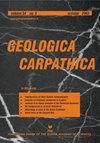下中新世长英质岩石年代学和岩石成因:马拉提亚西南部-东安纳托利亚(土耳其)碰撞后岩浆活动起源的新证据
IF 1.5
4区 地球科学
Q4 GEOSCIENCES, MULTIDISCIPLINARY
引用次数: 2
摘要
东南安纳托利亚造山带由变质岩体、花岗岩体、蛇绿岩、火山岩等多种构造岩浆和构造地层单元组成。本文报道了横切二叠-三叠系马拉提亚变质杂岩的中新世长英质(英英质和流纹岩)岩石的新锆石U-Pb LA-ICP-MS年龄、Sr-Nd同位素分析和全岩地球化学特征,以确定该地区岩浆活动和岩浆过程的来源。锆石U-Pb结晶年龄在16.66±0.23 Ma ~ 16.83±0.094 Ma之间,表明碰撞后火山活动开始于早中新世(burdigian)期。火山岩具有钙碱性和高钾钙碱性特征。长英质火山岩的87 Sr/ 86 Sr值在0.707098 ~ 0.711703之间。初始143 Nd/ 144 Nd比值在0.512446 ~ 0.512469之间,εNd值在−3.12 ~−3.66之间。Nd (T DM)模型年龄在1.05 ~ 1.13 Ga之间。负的εNd值和Nd (T DM)模式年龄与土耳其、伊朗和阿拉伯半岛的前寒武纪基底有很大的相似性。利用Sr-Nd同位素数据测试不同地壳来源的能量约束同化-分数结晶(EC-AFC)模型表明,原始岩浆含有重要的地壳熔体贡献。地球化学资料表明,长英质岩石可能是在碰撞后构造背景下,由地壳源性熔体与岩石圈幔源性基性熔体混合形成的。本文章由计算机程序翻译,如有差异,请以英文原文为准。
Geochronology and petrogenesis of the lower Miocene felsic rocks: New evidence for initiation of post-collisional magmatism in the SW Malatya – Eastern Anatolia (Turkey)
: The Southeast Anatolian Orogenic Belt (SAOB) consists of various tectono-magmatic and tectono-stratigraphic units such as metamorphic massifs, granitoids, ophiolites and volcanic rocks. In this study, we report new zircon U–Pb LA-ICP-MS ages, Sr–Nd isotope analysis and whole-rock geochemistry from Miocene felsic (dacitic and rhyolitic) rocks cross-cutting the Permo–Triassic Malatya metamorphic complex to determine the source of magmatism and magmatic processes in the region. The zircon U–Pb crystallisation ages are between 16.66 ± 0.23 Ma and 16.83 ± 0.094 Ma, implying the start of the post-collisional volcanism in the Early Miocene (Burdigalian) period. Volcanic rocks have calc-alkaline and high-K calc-alkaline characters. The 87 Sr/ 86 Sr values for the felsic volcanics range between 0.707098 and 0.711703. The initial 143 Nd/ 144 Nd ratios are between 0.512446 and 0.512469, and the εNd values vary from −3.12 to −3.66. The Nd (T DM ) model ages are between 1.05 and 1.13 Ga. Negative εNd values and Nd (T DM ) model ages show great similarities with the Precambrian basement in Turkey, Iran and the Arabian peninsula. Energy-constrained assimilation– fractional crystallisation (EC-AFC) models testing different crustal sources using Sr–Nd isotope data show that primary magmas contain significant crustal melt contributions. Geochemical data indicate that the felsic rocks may have originated from crust-derived melts mixed with lithospheric mantle-derived mafic melts during its residence in the upper crust in a post-collisional tectonic setting.
求助全文
通过发布文献求助,成功后即可免费获取论文全文。
去求助
来源期刊

Geologica Carpathica
地学-地球科学综合
CiteScore
2.40
自引率
23.10%
发文量
26
审稿时长
>12 weeks
期刊介绍:
GEOLOGICA CARPATHICA covers a wide spectrum of geological disciplines including geodynamics, tectonics and structural geology, volcanology, stratigraphy, geochronology and isotopic geology, karstology, geochemistry, mineralogy, petrology, lithology and sedimentology, paleogeography, paleoecology, paleobiology and paleontology, paleomagnetism, magnetostratigraphy and other branches of applied geophysics, economic and environmental geology, experimental and theoretical geoscientific studies. Geologica Carpathica , with its 60 year old tradition, presents high-quality research papers devoted to all aspects not only of the Alpine-Carpathian-Balkanian geoscience but also with adjacent regions originated from the Mediterranean Tethys and its continental foreland. Geologica Carpathica is an Official Journal of the Carpathian-Balkan Geological Association.
 求助内容:
求助内容: 应助结果提醒方式:
应助结果提醒方式:


